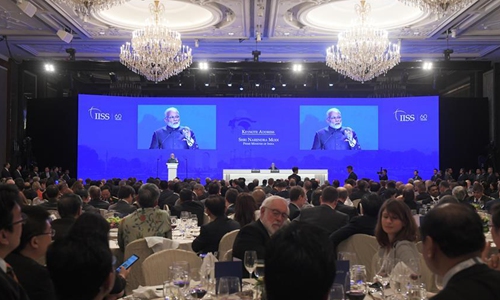HOME >> OPINION
India raises own version of Indo-Pacific to maximize interests
By Long Xingchun Source:Global Times Published: 2019/12/29 21:55:36

Indian Prime Minister Narendra Modi delivers a keynote speech at the 17th Shangri-La Dialogue held in Singapore on June 1, 2018. Photo: Xinhua/Then Chih Wey
In an address at the recent joint Indian Ocean Dialogue and Delhi Dialogue, Indian Foreign Minister S Jaishankar pointed out that India's view of the Indo-Pacific includes the Western Indian Ocean as well as neighbors in the Gulf, the island countries of the Arabian Sea and partners in Africa, adding that the Indo-Pacific is an "open, free and inclusive" platform.
This is arguably the most authoritative and systematic explanation from a senior Indian official about the Indo-Pacific after Prime Minister Narendra Modi's speech at the 2018 Shangri-La Dialogue in June where he crafted his country's stance on the subject.
The Indo-Pacific as an international political concept emerged more than a decade ago, but only became a hot topic after the administration of US President Donald Trump raised the Indo-Pacific strategy in 2017. This reflects the rising strategic status of India and the Indian Ocean.
Since the late 1990s, the Indian economy has clocked a fast growth and India has become an important emerging country. The international community has been optimistic about the prospects of India and even predicted that it may beat Japan to become the world's third largest economy around 2030. Many major powers, including the US, China, Russia, Japan, the UK and France, view India as a big country and some supported New Delhi in its demand to become a permanent member of the UN Security Council. The US and Japan, from a geopolitical point of view, even try to woo India as their partner that could contain China.
The Indo-Pacific concept shows the ever close economic relations between the Indian Ocean and the Pacific. In the mid-1990s India floated the "Look East" policy, which was upgraded to the "Act East" policy by Modi in 2014, aiming to strengthen economic cooperation with the prosperous East Asian region and participate in APEC.
Meanwhile, trade between East Asian countries and India, the Gulf region and Africa has been expanding. Africa and the Gulf region have become an important source of energy and raw materials and commodity markets for East Asia. 90 percent of trade between East Asia and Africa and Europe has to pass through the Indian Ocean. This contributes to the rising strategic position of the Indian Ocean, the security of which is closely watched by major powers.
But the Indo-Pacific strategy advocated by the US mainly intends to use India as a tool to contain China. The geographic scope of the Indo-Pacific under the US ranges from the west coast of India to the west coast of the US and does not include Gulf countries in the coastal areas of the Arabian Sea of the Indian Ocean and Africa in the west coast of the Indian Ocean.
The US Indo-Pacific strategy only needs India rather than the entire Indian Ocean and its coastal areas. Nor does it aim to strengthen economic cooperation with countries along the Indian Ocean. The fundamental target is China. The strategy serves US interests rather than those of Indo-Pacific countries including India.
Therefore, India has its own narrative of the Indo-Pacific based on its self-interest and intent. As a country that has sworn by the principle of non-alignment and now stresses strategic autonomy, if India follows the US Indo-Pacific strategy, it will not only jeopardize its pursuit of a major power, but also risk worsening ties with China.
Nonetheless, by proposing its own version of the Indo-Pacific strategy, India could strengthen cooperation with East Asia through its "Act East" policy and strengthen ties with the Gulf and African regions to its west. Thus it can become the center of the Indo-Pacific, which will help raise India's international standing and make India become an important participant of the Asia-Pacific as well as a dominant force in the Indian Ocean.
It is worth pointing out that any strategy or policy needs corresponding resources to make progress or it will just remain a concept. Given that a slew of international and regional plans proposed by India in recent years, such as the Project Mausam and the Spice Routes, did not proceed well, it is uncertain if the Indian version of the Indo-Pacific can go beyond being just a concept. But even if it remains a concept, it still deals a heavy blow to the US Indo-Pacific strategy.
The author is director of the Center for Indian Studies at China West Normal University and research fellow at the Charhar Institute. opinion@globaltimes.com.cn
Posted in: ASIAN REVIEW